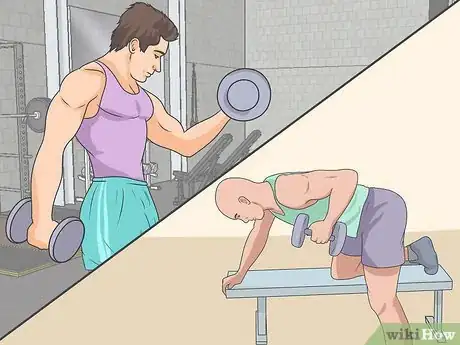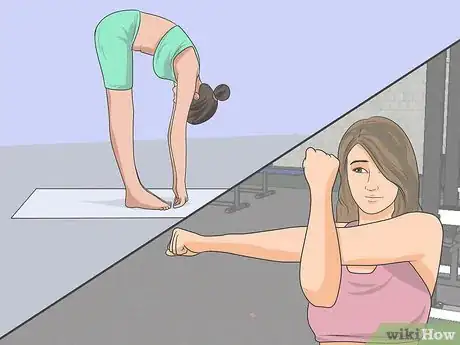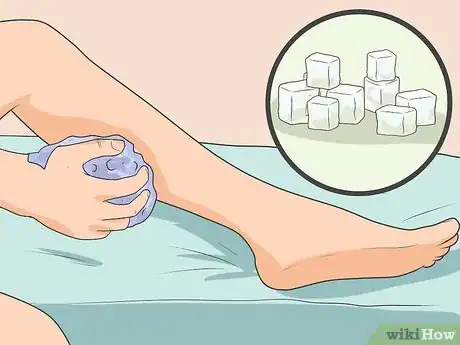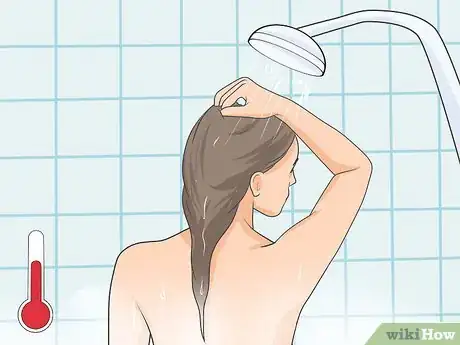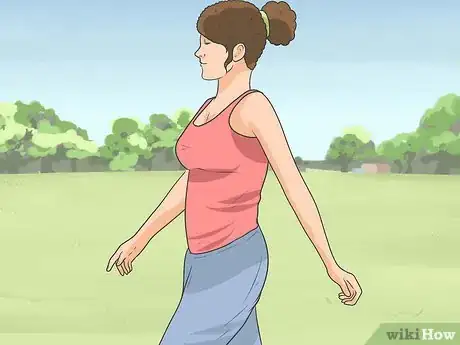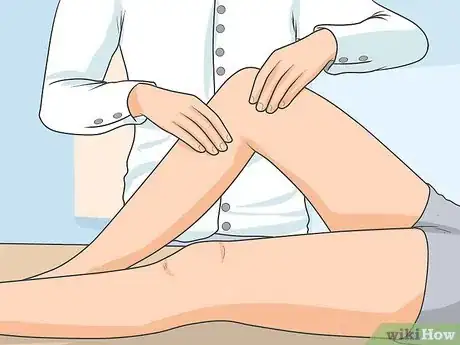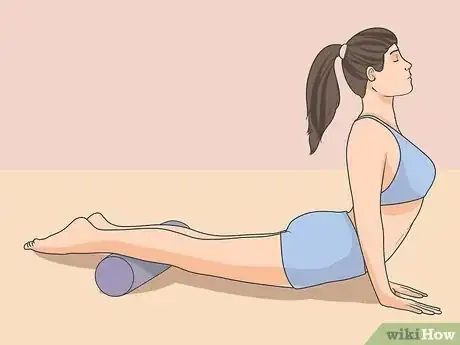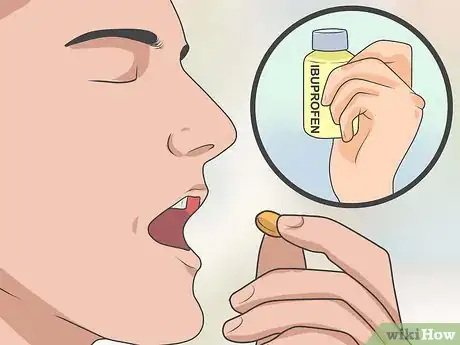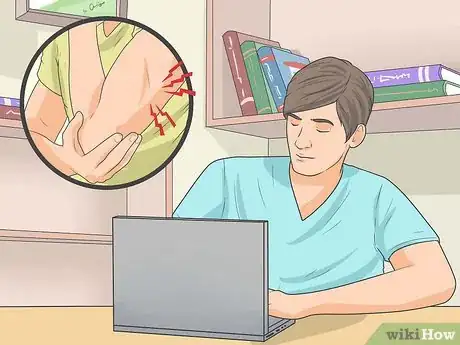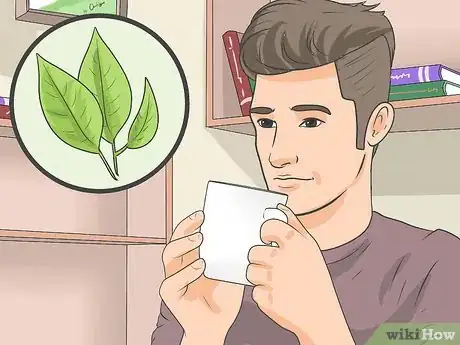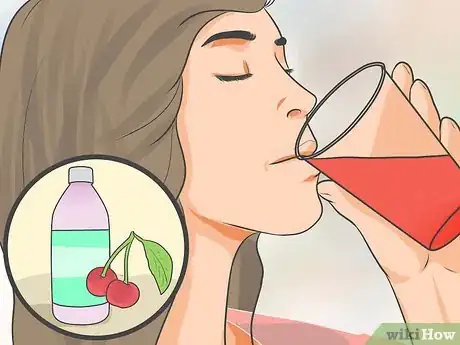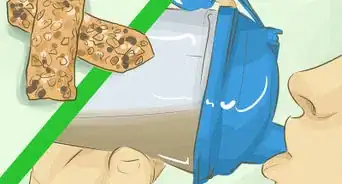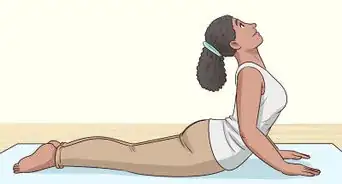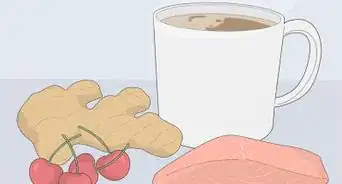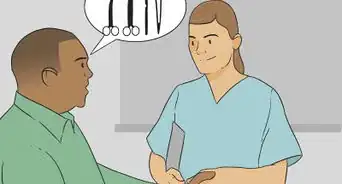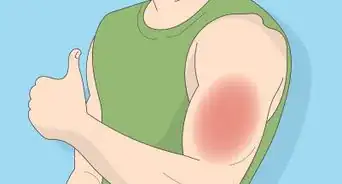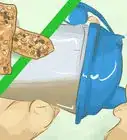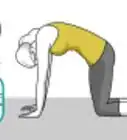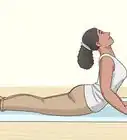This article was co-authored by Scott Anderson, MA, ATC, SFMA, DNSP. Scott Anderson is the Chief Clinical Officer at SyncThink, an award winning startup founded out of Stanford University. Scott previously served as the Director of Sports Medicine/Athletic Training for Stanford University for over ten years from 2007 to 2017. Scott has over 18 years of clinical and management experience, and is a recognized international speaker on topics of clinical specialization, which include developmental kinesiology, neuroscience/concussion, and movement dysfunction. He is a certified Dynamic Neuromuscular Stabilization Practitioner (DNSP), Sports Safety Specialist and is certified to conduct Selective Functional Movement Assessments (SFMA), and Functional Movement Screenings (FMS). He earned a BS in Athletic Training from Washington State University in 2000 and an MA in Athletic Administration from Saint Mary's College in 2002.
There are 19 references cited in this article, which can be found at the bottom of the page.
wikiHow marks an article as reader-approved once it receives enough positive feedback. This article received 11 testimonials and 100% of readers who voted found it helpful, earning it our reader-approved status.
This article has been viewed 3,151,666 times.
Muscles can often feel sore after exercise or other strenuous activity. Although muscle pain can be aggravating and keep you from exercising, the good news is that the more you exercise, the less your muscles will hurt in the weeks to come. Use these simple tips to alleviate common muscle soreness!
Steps
Treating Muscles During a Workout
-
1Warm up and ease into your workout. For your muscles to be limber and avoid injury during intense exercise, you must ease into your routine which gives them time to become warm and pliable. Avoid jumping right into a heavy or intense workout routine.
- Start with light exercises and gradually increase the intensity.[1]
- For example, if you're weightlifting, begin with easy repetitions of light hand weights before you begin intense bench presses.
-
2Stretch properly. Stretching at the start and end of your workout will also help to get the lactic acid out of your muscles. Waiting hours after a strenuous workout before stretching is not the best. Stretch soon after activity that may cause soreness to prevent becoming stiff.
- Be sure to stretch after warming up, as your muscles will be more limber and less likely to become injured.
Advertisement -
3Stay hydrated. Dehydration at the start of an exercise routine or sport is dangerous not only because it can cause you to become light-headed and faint, but also because it can lead to muscle soreness afterwards. Proper hydration during intense physical exercise increases oxygen to your muscles, which gives your muscles more stamina and also aids in their recovery as you work out.[2]
- Don't load up on water directly before you exercise, which can cause bloating and cramping. Instead, hydrate gradually in the 24 to 48 hours leading up to an intense workout.[3]
- Drink half of your body weight in fluid ounces of water per day. So, if you weigh 128 lb (58 kg), you should consume 64 fl oz (1,900 ml) of water per day.[4]
- Be sure to stay well hydrated during your workout: aim to drink 1 cup (240 ml) of water for every 15 minutes of intense exercise.[5]
Soothing Muscles After a Workout
-
1Ice up. Ice-cold water immediately after an intense muscle workout has been shown to reduce muscle soreness more than any other single treatment.[6] It reduces muscle inflammation and prevents much of the soreness from lingering in your muscles. [7] If you are a professional or college athlete or workout at an elite gym, you might have an ice bath there that you can utilise to help reduce muscle soreness. If not, try these strategies instead:
- Jump into a cold shower or bath. The colder, the better: professional athletes use ice water, but if you can't stand it, just use cold tap water.
- If you're an athlete, consider investing in a five-gallon bucket. Fill it with ice water, then submerge your sore arm or foot.
- If you're using an ice pack always wrap it in a cloth before you apply it. This will keep the extreme cold from injuring your skin.[8]
- If you need to be moving around, try wrapping plastic wrap around your ice pack to secure it to your body.
- Ice your muscles for 10 – 20 minutes.
-
2Heat up. While the first step should always be ice, a few hours later it’s a good idea to apply heat to the affected muscles to help stimulate blood flow to your muscles and help them to remain limber instead of tight.[9] Apply heat for about 20 minutes.
- Take a hot shower or bath. The water will relax your muscles as you soak.
- Try adding 2-4 heaping tablespoons of Epsom salts to your bath to help soothe sore muscles.Adding Epsom salts to your bathwater is an effective home remedy for sore muscles.[10] [11]
- For stiff neck, take uncooked rice and fill a tube sock and tie off the end. Microwave for 1.5 minutes and use as a heat wrap. It is reusable.
- For isolated sore muscles, you can apply peel-and-stick heating pads directly to the skin and wear them under your clothes for hours. These can be purchased at most pharmacies.[12]
-
3Keep moving. While it's tempting to completely relax your muscles as you recover, studies show that light activity that uses your sore muscles can reduce the length of time that you're sore. It's important to give your muscles time to recover, though, so be sure that you don't overdo it.[13]
- Exercise helps muscle soreness by increasing blood flow to the affected muscles, which helps them to eliminate waste more quickly and keep muscles from becoming stiff.
- Consider the intensity level of the workout that made you sore, and then do a lighter version of that activity the next day (similar to the intensity of a warm-up).[14]
- For example, if running five miles has you sore, take a brisk walk for a half a mile to a mile.
-
4Get a massage. When you exercise to exhaustion, tiny tears occur in muscle fibers. The body's natural response to these tears is inflammation. Massage helps reduce the amount of cytokines the body produces, which play a role in inflammation.[15] Massage also seems to increase the amount of mitochondria in your muscle, which enhances the muscles' ability to extract oxygen.[16]
- Massage also helps move lactic acid, lymph, and other stagnant toxins from the muscles.
- Seek out a massage therapist and allow him to work on your sore muscles. Massage therapy is relaxing, meditative, and healing.
- Massage the muscles yourself. Use a combination of your thumbs, knuckles and palms to work deep into the muscle tissue.
- You can also use a lacrosse or tennis ball to really work into knots and take the pressure off your hands.
- If you are massaging a sore muscle, focus most of your attention on the connections at each end. This will help the muscle to relax more quickly.[17]
-
5Invest in a foam roller. These handy devices make it possible to give yourself a soothing deep-tissue massage both before and after working out, which can loosen up your muscles and help prevent soreness as well as treating muscles and knots that are already sore.[18] These are very useful for sore thigh and leg muscles but can also be used on the back, chest, and buttocks. Press the roller into the sore muscle and rub it up and down. The action helps relieve tension and stress.
- Known as "self-myofascial release," this is a popular technique for anyone who participates in sports or fitness activities.[19]
- You can purchase a foam roller at any athletic store or online.
- Check out this helpful wikiHow article for advice on how to use your foam roller to best soothe sore muscles.
- If you don't want to spend the $20 – $50 on a foam roller, you can use a lacrosse ball or tennis ball to roll under your body.
-
6Take pain medication. If you need immediate relief, try acetaminophen or a nonsteroidal anti-inflammatory drug (also known as NSAIDs) like ibuprofen, naproxen, or aspirin.[20]
- If you're 18 or younger, don't use aspirin. In children under 18, aspirin has been linked to a dangerous disease called Reye's syndrome, which results in acute brain damage.[21]
- Try to avoid using NSAIDs on a regular basis. NSAIDs might reduce your muscles' ability to repair themselves naturally if you take them too frequently.[22]
-
7Know when soreness is normal and when it signals a problem. The feeling of muscle soreness after an intense workout or when you exercise muscles that have not seen much action lately is usually normal, but there are some signs to watch out for that might indicate a more serious condition.
- Normal muscle pain usually hits a day after your workout, especially if you changed your routine, increased the intensity, or worked different muscles than usual.[23]
- Pay attention to any sudden shooting pains that happen while working out, which can signal a torn muscle.
- Also, watch for pain in your joints which might signal osteoarthritis or damage to a ligament or meniscus.[24]
- Call your doctor if you experience any muscle pain that comes on suddenly, doesn't respond to OTC pain medication, or doesn't start to resolve after a few days.[25]
Preventing Muscle Soreness
-
1Plan a proper diet, including keeping hydrated. If your muscles are sore from intense activities such as weightlifting, your muscles are rebuilding themselves, needing water and lots of protein. For optimal muscle growth, consume 1 gram (0.035 oz) of protein per day for every pound of lean body mass that you have, or, consume 0.22% of your lean body mass in protein.
- A man who weighs 150 pounds (68 kg) with 20% body fat has 120 pounds (54 kg) of lean mass, and should consume 120 grams (4.2 oz) of protein per day.
- Eat protein 15 to 45 minutes after workout for best results. This will speed up recovery times considerably, as well as prevent muscle loss from poor nutrition.
- Drink lots of water while you work out and throughout the day. Your muscles need water to function at their peak, and your body needs water to repair your muscles.
- Eating carbohydrates before and after your workout aids in muscle recovery and gives you the fuel necessary to power through your routine.[26]
-
2Consider taking vitamins, antioxidants, and other supplements. Muscles need particular vitamins and minerals to repair properly as you work out, so prepping the body with the right supplements will help prepare it for strenuous exercise.
- Vitamin C and antioxidants are especially effective in helping to prevent muscle soreness.[7]
- Blueberries, artichokes, and green tea are antioxidant-rich, while chili peppers, guavas, and citrus fruits are all high in vitamin C.[27]
- Supplements like branched-chain amino acids, l-glutamine, l-arginine, betaine, or taurine may help promote recovery and protein turnover, which can help you build muscle.
- Eat more protein or add a protein supplement to your diet to help your body rebuild muscles.[28]
- Consider adding creatine to your diet to help your muscles repair themselves more quickly after an intense workout. [29]
-
3Try tart cherry juice. Sour cherry juice is quickly becoming recognized as a superfood, known for its antioxidants and other benefits. In one study, scientists found that tart cherry juice provided relief for mild to moderate muscle soreness.[30]
- You can find 100% tart cherry juice at most major grocery stores or health food stores.
- Look for a brand that does not mix the juice with another type (for instance, cherry-apple juice), as those brands tend to put in a minimum amount of cherry.
- Also, be sure that the juice does not contain any added sugar or other ingredients.
- Try using tart cherry juice as the basis for a post-workout smoothie, or drink it on its own.
Expert Q&A
-
QuestionWhat is the best way to get rid of soreness?
 Scott Anderson, MA, ATC, SFMA, DNSPScott Anderson is the Chief Clinical Officer at SyncThink, an award winning startup founded out of Stanford University. Scott previously served as the Director of Sports Medicine/Athletic Training for Stanford University for over ten years from 2007 to 2017. Scott has over 18 years of clinical and management experience, and is a recognized international speaker on topics of clinical specialization, which include developmental kinesiology, neuroscience/concussion, and movement dysfunction. He is a certified Dynamic Neuromuscular Stabilization Practitioner (DNSP), Sports Safety Specialist and is certified to conduct Selective Functional Movement Assessments (SFMA), and Functional Movement Screenings (FMS). He earned a BS in Athletic Training from Washington State University in 2000 and an MA in Athletic Administration from Saint Mary's College in 2002.
Scott Anderson, MA, ATC, SFMA, DNSPScott Anderson is the Chief Clinical Officer at SyncThink, an award winning startup founded out of Stanford University. Scott previously served as the Director of Sports Medicine/Athletic Training for Stanford University for over ten years from 2007 to 2017. Scott has over 18 years of clinical and management experience, and is a recognized international speaker on topics of clinical specialization, which include developmental kinesiology, neuroscience/concussion, and movement dysfunction. He is a certified Dynamic Neuromuscular Stabilization Practitioner (DNSP), Sports Safety Specialist and is certified to conduct Selective Functional Movement Assessments (SFMA), and Functional Movement Screenings (FMS). He earned a BS in Athletic Training from Washington State University in 2000 and an MA in Athletic Administration from Saint Mary's College in 2002.
Sports Medicine & Injury Prevention Specialist Yoga can be a excellent, relaxing form of exercise during your recovery day.
Yoga can be a excellent, relaxing form of exercise during your recovery day. -
QuestionHow can I speed up my recovery when dealing with sore muscles?
 Scott Anderson, MA, ATC, SFMA, DNSPScott Anderson is the Chief Clinical Officer at SyncThink, an award winning startup founded out of Stanford University. Scott previously served as the Director of Sports Medicine/Athletic Training for Stanford University for over ten years from 2007 to 2017. Scott has over 18 years of clinical and management experience, and is a recognized international speaker on topics of clinical specialization, which include developmental kinesiology, neuroscience/concussion, and movement dysfunction. He is a certified Dynamic Neuromuscular Stabilization Practitioner (DNSP), Sports Safety Specialist and is certified to conduct Selective Functional Movement Assessments (SFMA), and Functional Movement Screenings (FMS). He earned a BS in Athletic Training from Washington State University in 2000 and an MA in Athletic Administration from Saint Mary's College in 2002.
Scott Anderson, MA, ATC, SFMA, DNSPScott Anderson is the Chief Clinical Officer at SyncThink, an award winning startup founded out of Stanford University. Scott previously served as the Director of Sports Medicine/Athletic Training for Stanford University for over ten years from 2007 to 2017. Scott has over 18 years of clinical and management experience, and is a recognized international speaker on topics of clinical specialization, which include developmental kinesiology, neuroscience/concussion, and movement dysfunction. He is a certified Dynamic Neuromuscular Stabilization Practitioner (DNSP), Sports Safety Specialist and is certified to conduct Selective Functional Movement Assessments (SFMA), and Functional Movement Screenings (FMS). He earned a BS in Athletic Training from Washington State University in 2000 and an MA in Athletic Administration from Saint Mary's College in 2002.
Sports Medicine & Injury Prevention Specialist Something as simple as an Epsom salt bath is a pretty common, tested strategy for promoting relaxation for your muscle tissue and helping facilitate recovery. I also think practicing mindfulness and relaxing breathing techniques can promote recovery and relaxation in muscle tissue. We have to be able to alleviate that tension by clearing our mind.
Something as simple as an Epsom salt bath is a pretty common, tested strategy for promoting relaxation for your muscle tissue and helping facilitate recovery. I also think practicing mindfulness and relaxing breathing techniques can promote recovery and relaxation in muscle tissue. We have to be able to alleviate that tension by clearing our mind.
Warnings
- Joint pain is a serious problem and can result in sustained, critical injury. Try not to confuse muscle pain and joint pain. If the pain does not go away after a few days rest and the other procedures prescribed here, it may be wise to contact a physician.⧼thumbs_response⧽
- Be careful if you plan to immerse a whole arm as indicated above with the 5 gallon (18.9 L)-bucket method. This may result in a rapid loss of body warmth and may affect your circulation. Do NOT do this if you have blood pressure or heart problems. Even if you are completely healthy, proceed slowly by dipping your arm in bit by bit, starting at the fingertips, especially if it is a hot day. It may be even better to make something resembling a Popsicle from regular water and wiping the arm with it (again, starting at the fingers), then drying immediately and massaging (moving from the hand towards the body). Be gentle to avoid causing pain or over-agitating the muscles.⧼thumbs_response⧽
- Sustained icing of sore muscles is not very effective. It is generally recommended to ice for 15 – 20 minutes, taking the ice off for the same 15 – 20 minutes, and repeat as desired. The reason for this is that icing for longer than the 15 – 20 minutes will not cool the muscle any more than it already is. Also, if iced for too long, the icing period can lead to frostbite, damage of the soft tissue, or skin damage.⧼thumbs_response⧽
References
- ↑ http://www.webmd.com/fitness-exercise/art-sore-muscles-joint-pain?page=3
- ↑ http://www.besthealthmag.ca/best-you/health/how-to-stay-hydrated-while-you-exercise
- ↑ http://www.besthealthmag.ca/best-you/health/how-to-stay-hydrated-while-you-exercise
- ↑ http://www.pbs.org/americaswalking/fuel/fueldrinking.html
- ↑ http://www.besthealthmag.ca/best-you/health/how-to-stay-hydrated-while-you-exercise
- ↑ http://www.everydayhealth.com/fitness/quick-fixes-for-sore-muscles.aspx
- ↑ 7.07.1http://www.webmd.com/fitness-exercise/features/art-sore-muscles-joint-pain?page=2
- ↑ http://www.mensfitness.com/training/5-cures-for-sore-muscles-that-really-work/slide/5
- ↑ http://www.everydayhealth.com/fitness/quick-fixes-for-sore-muscles.aspx
- ↑ Scott Anderson, MA, ATC, SFMA, DNSP. Sports Medicine & Injury Prevention Specialist. Expert Interview. 24 March 2020.
- ↑ http://www.shape.com/lifestyle/mind-and-body/6-unconventional-ways-treat-sore-muscles
- ↑ http://www.womenshealthmag.com/fitness/5-ways-to-ease-sore-muscles
- ↑ http://www.womenshealthmag.com/fitness/5-ways-to-ease-sore-muscles
- ↑ http://www.womenshealthmag.com/fitness/5-ways-to-ease-sore-muscles
- ↑ http://well.blogs.nytimes.com/2012/02/06/how-massage-heals-sore-muscles/
- ↑ http://www.webmd.com/pain-management/news/20120201/massage-may-help-sore-muscles-recover
- ↑ http://www.mensfitness.com/training/5-cures-for-sore-muscles-that-really-work/slide/7
- ↑ Scott Anderson, MA, ATC, SFMA, DNSP. Sports Medicine & Injury Prevention Specialist. Expert Interview. 24 March 2020.
- ↑ http://breakingmuscle.com/mobility-recovery/what-is-a-foam-roller-how-do-i-use-it-and-why-does-it-hurt
- ↑ http://www.webmd.com/fitness-exercise/art-sore-muscles-joint-pain?page=2
- ↑ http://www.nlm.nih.gov/medlineplus/ency/article/001565.htm
- ↑ http://www.webmd.com/fitness-exercise/art-sore-muscles-joint-pain?page=2
- ↑ http://www.webmd.com/fitness-exercise/art-sore-muscles-joint-pain
- ↑ http://www.webmd.com/fitness-exercise/art-sore-muscles-joint-pain
- ↑ http://www.webmd.com/fitness-exercise/art-sore-muscles-joint-pain?page=2
- ↑ http://www.bodybuilding.com/fun/a-beginners-guide-to-workout-nutrtion.html
- ↑ http://www.healthaliciousness.com/articles/vitamin-C.php
- ↑ http://www.webmd.com/fitness-exercise/art-sore-muscles-joint-pain?page=2
- ↑ http://www.shape.com/lifestyle/mind-and-body/6-unconventional-ways-treat-sore-muscles
- ↑ w.shape.com/lifestyle/mind-and-body/6-unconventional-ways-treat-sore-muscles
- ↑ Scott Anderson, MA, ATC, SFMA, DNSP. Sports Medicine & Injury Prevention Specialist. Expert Interview. 24 March 2020.
About This Article
To make sore muscles feel good, try applying ice for 10-20 minutes or jumping in an ice-cold shower, as the cold reduces muscle inflammation. If you still feel sore a few hours later, try taking a hot shower or using a heating pad for about 20 minutes to stimulate blood flow to your muscles. It might be tempting to completely relax, but some light exercise might reduce your discomfort by increasing blood flow to your muscles. Additionally, you can also get a massage, which helps reduce the amount of cytokines your body produces and reduce inflammation. For more tips from our Personal Trainer co-author, including how to prevent muscle soreness during workouts, read on!
